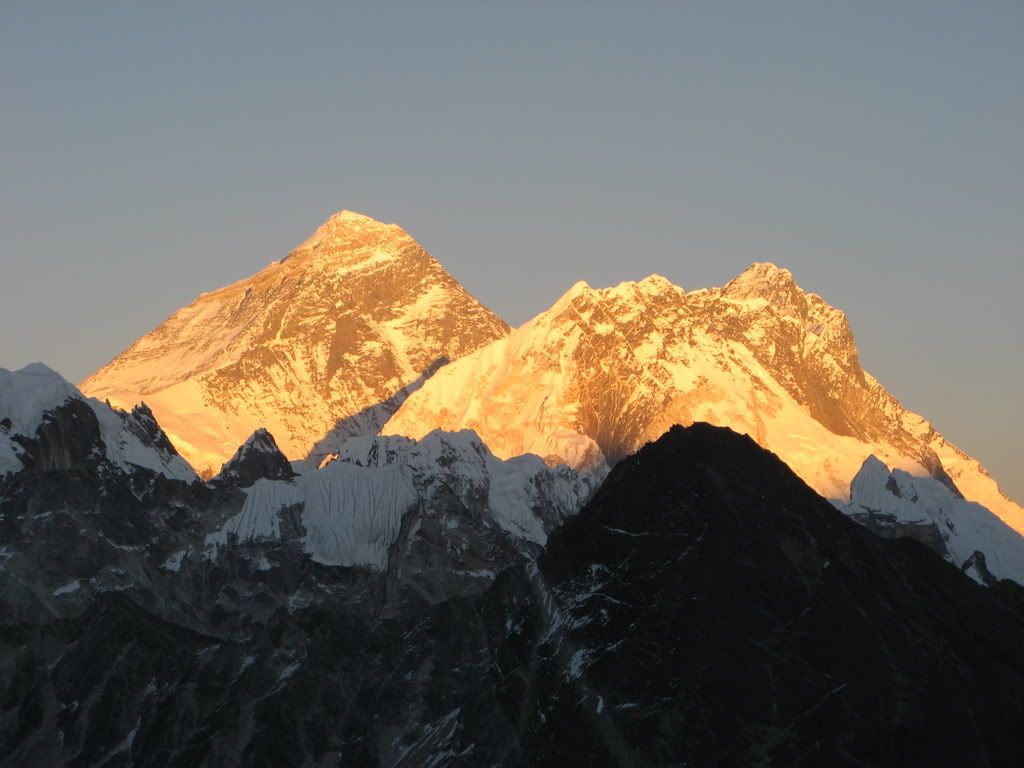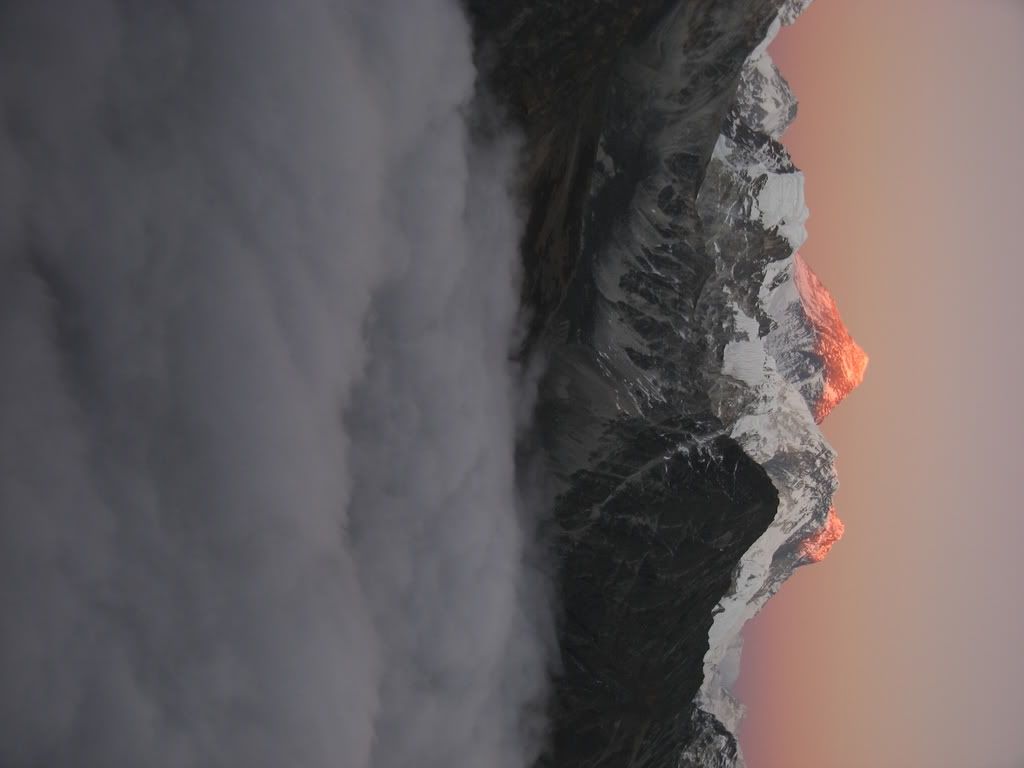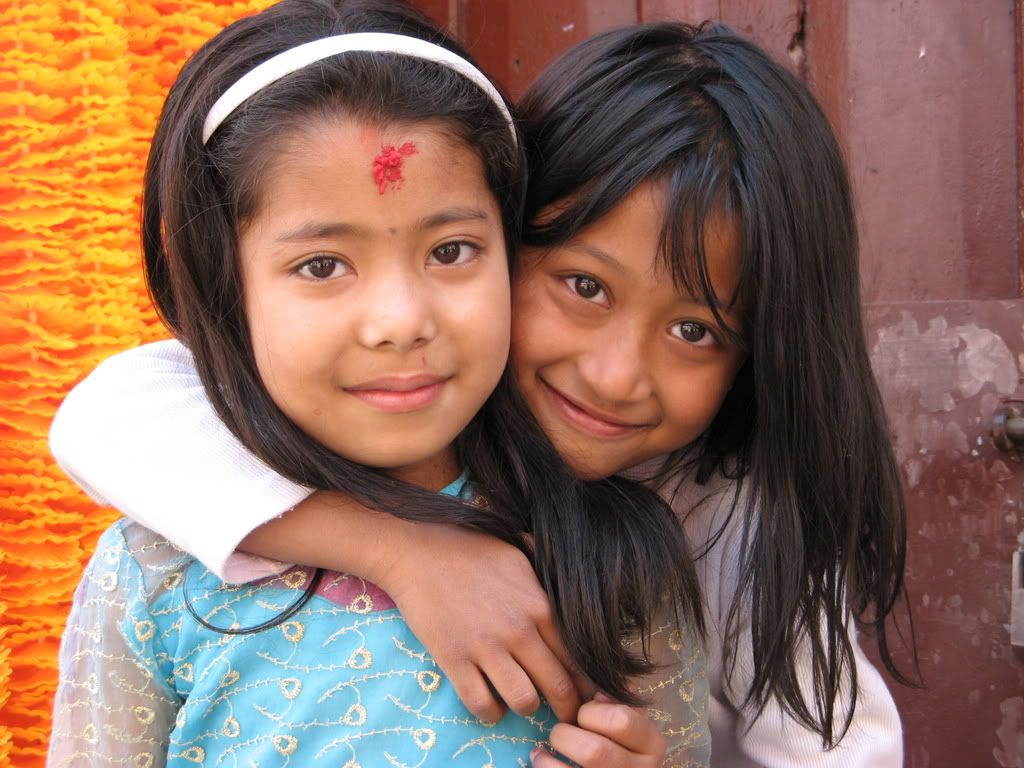The morning after that amazing afternoon on Gokyo Ri, Holger, Dep and I traveled further up the valley along the Ngozumpa Glacier to "Lake Five." If you look back to my first post on this trek there is a picture of the village of Gokyo next to a beautiful turquoise lake. If I remember correctly, that was "Lake Three". There were five lakes along the glacier. Lake Five was the last and closest to the peaks that feed the glacier, including the the giant Cho Oyo (26,906 ft.) I believe this is a picture of Lake Four looking back down the valley:

Since the hike to Lake Five was in the opposite direction from the village where we would be staying that night, Santosh went on without us in order to secure a room. It was high season for trekking and we didn't want there to be "no room at the inn."
After our hike to Lake Five we returned the way we came, traveling down the glacier a little way past Gokyo. Our goal was to reach Dragnag, the village where we would spend the night before our big climb to Cho La pass the next day. The exciting part was that we would cross the Ngozumpa Glacier (the largest in Nepal) to get to it.
Just in case, here's a little glacier lesson: The snow that falls on the mountains gets compacted as more snow accumulates on top of it, turns to ice and flows downward at a, ahhh, glacial pace--sorry couldn't resist. So, in essence, it is a river of ice.
At first I was a little disappointed that the glacier wasn't the pristine, white, icy thing I had imagined it would be. Instead it was a dirty, grayish, rocky thing:
 But my disappointment soon evaporated. Once on the glacier, it was extraordinary beautiful, like being on another planet, with ice rimmed pools and even sand dunes:
But my disappointment soon evaporated. Once on the glacier, it was extraordinary beautiful, like being on another planet, with ice rimmed pools and even sand dunes:
 It only took, maybe, 15 minutes to cross, but I loved every minute of it.
It only took, maybe, 15 minutes to cross, but I loved every minute of it.As I mentioned in a previous post, to get to the valley where the Everest Base Camp is, we had to cross a range of mountains via Cho La pass (17,886 ft.). After our night in Dragnag (15,510 ft.) we set out before sunrise for the pass. It was going to be a long, hard day with an elevation gain of over 2300 ft., which we would then lose coming down the other side. We reached the pass in the late morning. It was a beautiful, cloudless sky with no wind so it was pure joy to rest and relax in the sun.
Here's a shot from the top of the pass looking back at the final, most difficult, part of our climb. It was steep and I had to use my hands in a few places. Now notice the porter (and the size of his load) about to make his way down!
 This is a picture of Holger, Dep, me and Santosh in our Cho La celebration picture. I love the body language in this one: Holger and Dep all chummy...
This is a picture of Holger, Dep, me and Santosh in our Cho La celebration picture. I love the body language in this one: Holger and Dep all chummy... By the way, Dad, on the pass I met an American guy and his 74 year old father doing this trek together. You've got two and a half years, better start training.
By the way, Dad, on the pass I met an American guy and his 74 year old father doing this trek together. You've got two and a half years, better start training.This shot is looking back towards the top of the pass as we made our way down the other side. It's the only time we had to travel on snow. Fortunately it was only for a short distance and not very steep.

You'll be interested to know that after this difficult day, the place we stayed that night was the nightmare guest house I described in the last post.
The next day was a relatively short hike to Gorak Shep, the last set of guest houses before Everest Base Camp. We arrived in the late morning and Santosh and I set out for the camp after lunch. It was a couple of hours of hiking from Gorak Shep along the Khumbu Glacier.
It's funny what you hear from other trekkers. One person will rave about something, another will say, not worth the trouble; but one of the most common comments I heard about the base camp was something like, "Oh, well, you can't really see anything," usually said in a "whatever" tone. What they mean is that you can't see the top of Everest (because you're too close to the mountain). Well, yes, that's true, but that doesn't mean you can't see anything. It was actually a beautiful hike and just being in the base camp was thrilling. I was even surprised to see an actual expedition was set up there. My understanding was that climbing Everest was done only in May, but apparently there are sometimes attempts this time of year. It was a Thai expedition climbing in celebration of their king's 80th birthday. Unfortunately, I've since learned, they had to turn back short of the top (link has a picture of the route and a description of the logistics involved in an Everest climb).
This is a photo of the some of their tents with the treacherous Khumbu ice fall in the background. That is where the ascent begins and many climbers and Sherpas have lost their lives negotiating its crevasses. There's also supposed to be the wreckage of a crashed helicopter in there but I can't find it.
 Just to prove there is "something to see," here's a picture of Nuptse that I took on the way back to the guest house:
Just to prove there is "something to see," here's a picture of Nuptse that I took on the way back to the guest house: Next to Gorak Shep is a small peak called Kala Patthar. Since, as I mentioned, base camp is too close to get a good view of the mountain, this is the place to get that view. It's also the highest point, elevation wise, of the trek at about 18,200 ft. Everest is still over 10,000 ft. higher at 29,029 ft.! For comparison, the highest peak in the continental U.S. is Californina's Mt. Whitney at 14,505 ft. Most climb Kala Patthar in the early morning to see the sunrise, so that's what we did. We left while it was still dark, snaking our way up the mountain with our headlamps. It was a lot like climbing Gokyo Ri--pretty challenging, taking an couple hours, if I remember correctly. But this time it was much colder!
Next to Gorak Shep is a small peak called Kala Patthar. Since, as I mentioned, base camp is too close to get a good view of the mountain, this is the place to get that view. It's also the highest point, elevation wise, of the trek at about 18,200 ft. Everest is still over 10,000 ft. higher at 29,029 ft.! For comparison, the highest peak in the continental U.S. is Californina's Mt. Whitney at 14,505 ft. Most climb Kala Patthar in the early morning to see the sunrise, so that's what we did. We left while it was still dark, snaking our way up the mountain with our headlamps. It was a lot like climbing Gokyo Ri--pretty challenging, taking an couple hours, if I remember correctly. But this time it was much colder!I have mixed feelings about this one. While, yes, it did have great views of Everest, the sun rises behind it! The light would have been a much better in the afternoon, like it was from Gokyo Ri. I don't know if this is the reason, but I'm guessing that it's traditionally climbed in the morning for timing reasons. For most people, it's probably too much to hike to Gorak Shep from Lobuche in the morning and then climb Kala Patthar in the afternoon. Instead you do the much easier hike to base camp and Kala Patthar the next morning since the hike that afternoon is downhill. Or it could be that the weather is usually better in the morning. I don't know.
Anyway, here are a couple of photos:
 As you can see, the light is terrible. By the way, the base camp is about where the where glacier makes a sharp left turn as it comes down the mountain.
As you can see, the light is terrible. By the way, the base camp is about where the where glacier makes a sharp left turn as it comes down the mountain.This one is a little more interesting. The sun rising over Nuptse, Everest is to the left:

Just to see the difference the light can make look back a few photos to Nuptse the previous afternoon.
But, really, what the hell do I have to complain about?!















